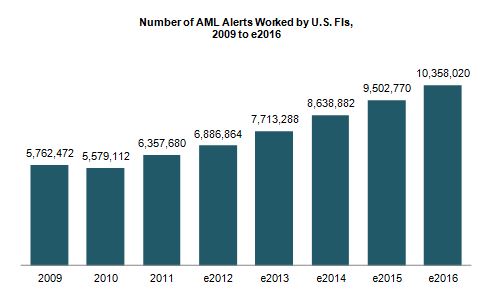Latest Posts

Julie Conroy - Research Director, Aite Group Finding patterns indicative of money laundering and other financial crimes is akin to searching for a needle in a haystack. With the increasing pressure on banks’ anti-money laundering (AML) and fraud teams, many with this responsibility increasingly feel like they’re searching for those needles while a combine is bearing down on them at full speed. These pressures include: Regulatory scrutiny: The high-profile—and expensive—U.S. enforcement actions that took place during the last couple of years underscore the extent to which regulators are scrutinizing FIs and penalizing those who don’t pass muster. Payment volumes and types increasing: As the U.S. economy is gradually easing its way into a recovery, payment volumes are increasing. Not only are volumes rebounding to pre-recession levels, but there have also been a number of new financial products and payment formats introduced over the last few years, which further increases the workload for the teams who have to screen these payments for money-laundering, sanctions, and global anti-corruption-related exceptions. Constrained budgets: All of this is taking place during a time in which top line revenue growth is constrained and financial institutions are under pressure to reduce expenses and optimize efficiency. Illicit activity on the rise: Criminal activity continues to increase at a rapid pace. The array of activity that financial institutions’ AML units are responsible for detecting has also experienced a significant increase in scope over the last decade, when the USA PATRIOT Act expanded the mandate from pure money laundering to also encompass terrorist financing. financial institutions have had to transition from activity primarily focused on account-level monitoring to item-level monitoring, increasing by orders of magnitude the volumes of alerts they must work (Figure 1) Figure 1: U.S. FIs Are Swimming in Alerts Source: Aite Group interviews with eight of the top 30 FIs by asset size, March to April 2013 There are technologies in market that can help. AML vendors continue to refine their analytic and matching capabilities in an effort to help financial insitutions reduce false positives while not adversely affecting detection rates. Hosted solutions are increasingly available, reducing total cost of ownership and making software upgrades easier. And many institutions are working on internal efficiency efforts, reducing vendors, streamlining processes, and eliminating the number of redundant efforts. How are institutions handling the increasing pressure cooker that is AML compliance? Aite Group wants to know your thoughts. We are conducting a survey of financial insitution executives to understand your pain points and proposed solutions. Please take 20 minutes to share your thoughts, and in return, we’ll share a complimentary copy of the resulting report. This data can be used to compare your efforts to those of your peers as well as to glean new ideas and best practices. All responses will be kept confidential and no institutions names will be mentioned anywhere in the report. You can access the survey here: SURVEY

When a data breach occurs, laws and industry regulations, dictate when and if you need to notify consumers whose data might have been compromised. However, many consumers would also probably argue that you’re morally obligated, to notify them of data loss; they want you to tell them of the breach and to do so in a courteous, straightforward manner. Because of this, a breach notification letter is an integral piece of a firm’s breach response as these often are the first inkling consumers have that their information may have been compromised, and their identities might be at risk. It’s imperative those letters be efficient, effective – and perhaps most importantly – humane. A 2014 study by the Ponemon Institute and Experian Data Breach Resolution indicates consumers feel there’s room for improvement in data breach notification letters. The survey polled people who had received a data breach notification letter. Sixty-seven percent of those surveyed said they want letters to better explain the risks and potential harms they may face as a result of the breach, 56 want the letter to disclose all the facts, and a third didn’t want the letter to “sugar-coat” the situation. A quarter wanted the letters to be more personal. The Experian Data Breach Resolution team has vast experience with breach notification letters and data breach notification regulations. In our experience, here are the five most common and egregious errors to avoid when sending a data breach notification letter: 1. Keeping the consumer in the dark about the details. Customers will want to know what information was compromised in the breach. Was it their Social Security number? A credit card number? Their home address? Consumers can’t protect themselves from further harm if they don’t know exactly what’s at risk. Don’t leave them guessing. Tell consumers exactly what information was compromised in the breach. 2. Speaking “legalese.” Reverting to legalese – highly complex verbiage largely understandable only to lawyers – is a defense mechanism for companies, and it doesn’t really help the consumer. Twenty-three percent of those polled by Ponemon said the letter they received would have been better if it had less legal or technical language. Keep letters short, factual and simply worded so that the average Joe or Jane can understand them. 3. Leaving out the ramifications and risks. It’s not enough to simply tell consumers they’ve been involved in a breach. It’s not even enough to tell them what information has been compromised. To truly empower them to protect themselves from further harm, you need to alert consumers to what those risks may be. Consider the type of data that was lost, then explain the risks that can be associated with that type of data loss. 4. Failing to offer an olive branch. Whether the breach was your fault or not, consumers will hold you responsible and they will feel they should get some kind of compensation for all the grief the breach will cause them. Providing breached customers with an identity protection product not only helps protect them, but it shields your company’s reputation, too. In the Ponemon study, 67 percent of consumers said they felt companies should offer some form of compensation – whether cash, product or service – to consumers caught in a data breach. Sixty-three percent said the company should offer them free identity theft protection and 58 percent wanted free credit monitoring. Interestingly, 43 percent also said a sincere and personal apology might help convince them to keep their business with the breached organization.. 5. Failing to seize the chance to rebuild trust. There’s no question that a data breach undermines customer trust. Some customers will leave a breached company. Among polled customers who remained with the breached company, inertia seemed a major factor in their decision not to go elsewhere; 67 percent said they stayed simply because it was too difficult to find someone else to offer the same products or services. Less than half (45 percent) said they stayed because they were happy with how the company handled the data breach. Breach letters are actually an opportunity to begin rebuilding trust. Explain to consumers what you’re doing to reduce the risk of future breaches, and how you’re taking steps to help protect them from further harm. Despite your best efforts, a data breach can occur. When it does, the data breach notification letter is your all-important point of first contact with affected consumers. Craft it well and the letter can be a valuable tool for mitigating reputation damage and rebuilding trust. Learn more from our Knowledge Center

As we discussed in our earlier Heartbleed post, there are several new vulnerabilities online and in the mobile space increasing the challenges that security professionals face. Fraud education is a necessity for companies to help mitigate future fraud occurrences and another critical component when assessing online and mobile fraud is device intelligence. In order to be fraud-ready, there are three areas within device intelligence that companies must understand and address: device recognition, device configuration and device behavior. Device recognition Online situational awareness starts with device recognition. In fraudulent activity there are no human users on online sites, only devices claiming to represent them. Companies need to be able to detect high-risk fraud events. A number of analytical capabilities are built on top of device recognition: Tracking the device’s history with the user and evaluating its trust level. Tracking the device across multiple users and evaluating whether the device is impersonating them. Maintaining a list of devices previously associated with confirmed fraud. Correlation of seemingly unrelated frauds to a common fraud ring and profiling its method of operation. Device configuration The next level of situational awareness is built around the ability to evaluate a device’s configuration in order to identify fraudulent access attempts. This analysis should include the following capabilities: Make sure the configuration is compatible with the user it claims to represent. Check out internal inconsistencies suggesting an attempt to deceive. Review whether there any indications of malware present. Device behavior Finally, online situational awareness should include robust capabilities for profiling a device’s behavior both within individual accounts and across multiple users: Validate that the device focus is not on activity types often associated with fraud staging. Confirm that the timing of the activities do not seem designed to avoid detection rules. By proactively managing online channel risk and combining device recognition with a powerful risk engine, organizations can uncover and prevent future fraud trends and potential attacks. Learn more about Experian fraud intelligence products and services from 41st Parameter, a part of Experian.
The discovery of Heartbleed earlier this year uncovered a large-scale threat that exploits security vulnerability in OpenSSL posing a serious security concern. This liability gave hackers access to servers for many Websites and put consumers’ credentials and private information at risk. Since the discovery, most organizations with an online presence have been trying to determine whether their servers incorporate the affected versions of OpenSSL. However, the impact will be felt even by organizations that do not use OpenSSL, as some consumers could reuse the same password across sites and their password may have been compromised elsewhere. The new vulnerabilities online and in the mobile space increase the challenges that security professionals face, as fraud education is a necessity for companies. Our internal fraud experts share their recommendation in the wake of the Heartbleed bug and what companies can do to help mitigate future occurrences. Here are two suggestions on how to prevent compromised credentials from turning into compromised accounts: Authentication Adopting layered security strategy Authentication The importance of multidimensional and risk-based authentication cannot be overstated. Experian Decision Analytics and 41st Parameter® recommend a layered approach when it comes to responding to future threats like the recent Heartbleed bug. Such methods include combining comprehensive authentication processes at customer acquisition with proportionate measures to monitor user activities throughout the life cycle. "Risk-based authentication is best defined and implemented in striking a balance between fraud risk mitigation and positive customer experience," said Keir Breitenfeld, Vice President of Fraud Product Management for Experian Decision Analytics. "Attacks such as the recent Heartbleed bug further highlight the foundational requirement of any online business or agency applications to adopt multifactor identity and device authentication and monitoring processes throughout their Customer Life Cycle." Some new authentication technologies that do not rely on usernames and passwords could be part of the broader solution. This strategic change involves the incorporation of broader layered-security strategy. Using only authentication puts security strategists in a difficult position since they must balance: Market pressure for convenience (Note that some mobile banking applications now provide access to balances and recent transactions without requiring a formal login.) New automated scripts for large-scale account surveillance. The rapidly growing availability of compromised personal information. Layered security "Layered security through a continuously refined set of ‘locks’ that immediately identify fraudulent access attempts helps organizations to protect their invaluable customer relationships," said Mike Gross, Global Risk Strategy Director for 41st Parameter. "Top global sites should be extra vigilant for an expected rush of fraud-related activities and social engineering attempts through call centers as fraudsters try to take advantage of an elevated volume of password resets." By layering security consistently through a continuously refined set of controls, organizations can identify fraudulent access attempts, unapproved contact information changes and suspicious transactions. Learn more about fraud intelligence products and services from 41st Parameter, a part of Experian.

The security world was taken by surprise earlier this month when researchers discovered Heartbleed, a new large-scale threat that exploits a security vulnerability in OpenSSL.

By: Maria Moynihan In less than a year, my information has been compromised twice by a data breach. The companies involved varied significantly by way of size and type, yet both reacted expeditiously to inform me of the incident. As much as I appreciated the quick response and notification, I couldn’t help but wonder how well prepared we all are to handle these types of incidents within our own organizations. I recently read somewhere that data breaches are to be expected – like death and taxes. Can this be true? A recent Ponemon Institute Study, 2013 Cost of a Data Breach, highlighted alarming statistics around the typical impact a breach has on an organization. With costs amounting to approximately $5.4M and impact to brands ranging anywhere from $184M to $330M in losses, organizations cannot afford to pass breaches off as inevitable. Organizations must tighten their security standards, understand the evolving data breach environment and ensure their response plans are continuously enhanced to address emerging issues. To better understand what may lie ahead, Experian has developed six key predictions for how concerns about data breaches will evolve: 1. Data breach cost will be down – but still impactful The cost per record of a data breach will continue to decline, however security incidents and other breaches may still cause significant business disruption if not properly managed. 2. Will the Cloud and Big Data = Big International Breaches? With the rise of the cloud, data is now moving seamlessly across borders making the potential for complex, international breaches more possible. 3. Healthcare Breaches: Opening the Floodgates With the addition of the Healthcare Insurance Exchanges, millions of individuals will be introduced into the healthcare system and as a result, will increase the vulnerability of the already susceptible healthcare industry. 4. A Surge in Adoption of Cyber Insurance Many companies will look beyond investing in technology to protect against attacks and towards the insurance market to manage financial ramifications of breaches. 5. Breach Fatigue – Rise in Consumer Fraud? As the number of reported breaches in the media increases and the frequency of notifications that consumers receive grow, they may become apathetic towards the subject, thereby exposing themselves to greater risk. 6. Beyond the Regulatory Check Box State regulators and law enforcement will turn a new leaf this year, devoting significant attention to helping organizations better manage breaches. What is your organization doing to improve its data breach preparedness plan? Check out our 2014 Data Breach Industry Forecast and guide to handling data breach response. Check out other related content on data breach resolution.

A recent survey focusing on the credit behavior of Millennials (age group 18 to 30) shows that 90 percent are familiar with cosigning and two-thirds have used a cosigner in the past.

Bankcard originations had a 32 percent year-over-year increase in Q4 2013 ($61 billion to $81 billion).

In an effort to understand consumer needs better and help lenders educate their customers, VantageScore® Solutions surveyed more than 200 lenders nationwide on the topic of score reason codes.

Auto financing became easier to obtain in Q4 2013 and the market share for new vehicle loans in the nonprime, subprime and deep-subprime credit tiers increased slightly to 34.1 percent of all new loans, up from 32.8 percent in Q4 2012.

According to Experian Marketing Services' annual Email Market Study, personalized promotional emails have 29 percent higher unique open rates and 41 percent higher unique click rates than nonpersonalized mailings.

The most recent Experian State of the Automotive Finance Market report shows more consumers are leasing vehicles. Leases accounted for 28.4 percent of all new vehicles financed in Q4 2013 - the highest level on record since 2006.

While access to small-business credit is improving and credit balances are increasing, key differences still remain across the United States.

Using a risk model based on older data can result in reduced predictive power.

Findings from the most recent Experian State of the Automotive Finance Market report show outstanding automotive loan balances increased 11 percent from Q4 2012, reaching $798.5 billion in Q4 2013 — the highest level since 2007.